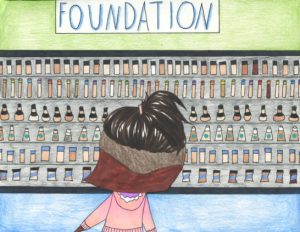By Angeli LaGuardia

Little girls used to scour the aisles of Toys R Us, excitement flushing their cheeks as they snatched up the latest Barbie makeup set, sprinting as fast as their little legs could carry them to beg their moms for the sparkling makeup. It was only a matter of time until moms were fed up with the overpriced nature of it all.
But now it’s 2018, and those same girls have become the women scavenging aisles at Sephora and Ulta, desperately searching to find a foundation shade that caters to their skin color. Unable to find their perfect match, it’s only a matter of time until beauty lovers lose their confidence in makeup all together.
Whether makeup is bought and utilized for the sole purpose of someones’ artistry or simply apart of their basic cosmetic routine, consumers should feel confident to depend on brands to sell foundation shades that cater to more than just the basic “Ivory,” “Bone white,” and “Beige” shades.
Cosmetic companies claim that the process to develop darker skin tones in the lab requires more time and attention, explaining why their release launch may be lacking in a darker shade range. But when inclusive brands like Fenty Beauty, Milk Makeup and Glossier redefine beauty standards with diverse products and shade range, it becomes painfully obvious that other brands aren’t modifying their makeup for women of color.
When mixing chemicals to create makeup for all, cosmetic tycoons must take into consideration a diverse variety of skin tones, those with underlying tones such as yellow and pink, and skin types. The beauty community understands that inclusive products take time to develop, yet they struggle to comprehend why these products still don’t exist. It’s not impossible to become inclusive, yet brands portray that it is.
Makeup brands claim they’re inclusive, yet struggle to come to terms with what diversifying actually means. Brands spend a majority of time and money promoting the release of a diverse collection, only for it to be the exact opposite. Just because a brand adds three “darker” shades to a predominantly white-based collection does not make it all inclusive. People of color remain underrepresented as consumers in the beauty community, and deserve recognition.
Reforming the makeup industry with inclusivity goes far beyond just the promotion of self esteem for beauty lovers. The rise of inclusive brands provides empowerment for people of color and promotes an end to racial underrepresentation.











